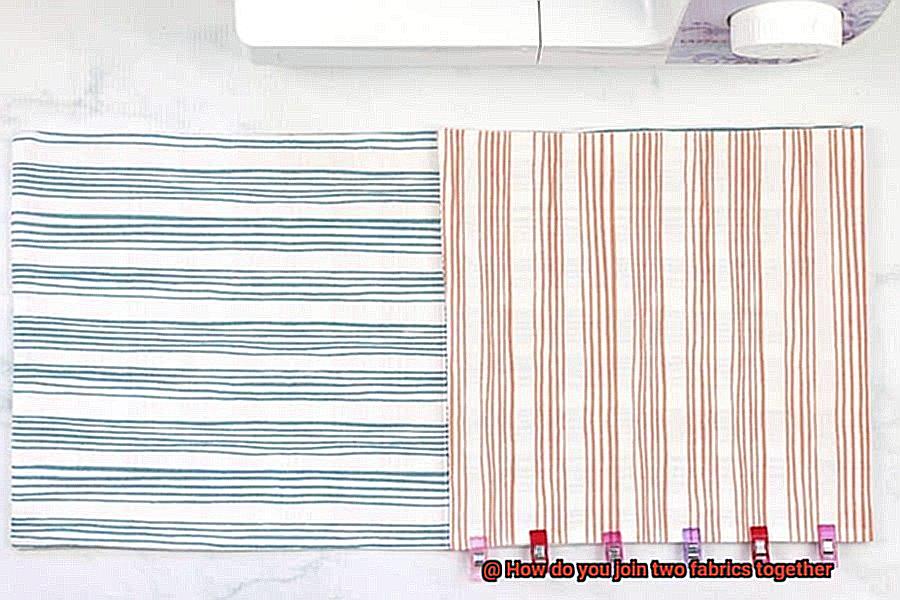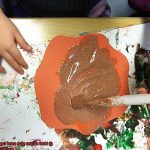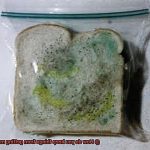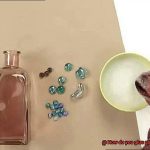Title: The Magic of Seamlessly Joining Fabrics Together
Introduction:
Contents
- 1 What is Fabric Joining?
- 2 Types of Fabric Joining Methods
- 3 Sewing: Advantages and Limitations
- 4 Using Fabric Glue: Advantages and Limitations
- 5 Fusible Web or Tape: Advantages and Limitations
- 6 Iron-on Patches: Advantages and Limitations
- 7 Fabric Adhesive Tapes: Advantages and Limitations
- 8 Choosing the Appropriate Method for Your Project
- 9 Conclusion
Hey there, fellow sewing enthusiasts. If you’re anything like me, you know that joining two fabrics together flawlessly is like unlocking a whole new level of crafting awesomeness. Whether you’re working on a snazzy patchwork quilt or reviving a tired old piece, mastering the art of fabric joining is the secret sauce to creating jaw-dropping results.
Now, before we dive into the nitty-gritty, let me tell you this: there’s more than one way to join fabrics. From good ol’ hand stitching to fancy-pants machines, each method has its own unique charm. We’ll be exploring all these techniques and more – from simple stitches to fancy French seams and versatile zigzag stitches – so grab your favorite cuppa and get ready to level up your sewing game.
Join me as we unravel the secrets behind achieving flawless fabric joins. We’ll be diving into various methods, tools, and tips that will help you create connections so strong they’ll withstand both time and wear. Get ready to take your sewing projects to new heights and unleash your inner creative genius. Let’s do this.
What is Fabric Joining?
Fabric joining is the art of bringing two separate pieces of fabric together to form one cohesive unit. This process can be accomplished through a variety of methods, each with its own unique advantages and limitations.
One of the most traditional and widely used methods of fabric joining is sewing. Whether done by hand or with a sewing machine, sewing involves using a needle and thread to stitch the fabric pieces together. This method provides a strong and durable bond, especially when reinforced with proper stitching techniques.
Adhesive bonding is another common method of fabric joining. By using adhesives or glue specially formulated for fabric, the pieces can be securely bonded together. Adhesive bonding offers flexibility and ease of use, as it requires no specialized equipment. However, it is crucial to choose the right adhesive for the fabric type to ensure a secure and long-lasting bond.
Heat bonding, also known as heat sealing or thermowelding, is frequently used in industrial applications. By applying heat to melt or soften the fabric surfaces, they can be fused together. This technique works particularly well for synthetic fabrics that easily melt and fuse. Heat bonding creates a strong bond that is resistant to tearing and unraveling.
For temporary or adjustable fabric joining, mechanical fastening methods such as snaps, buttons, zippers, Velcro, or hook-and-loop tape are commonly employed. These methods allow for easy attachment and detachment of fabric pieces without permanent bonding. Mechanical fasteners provide convenience and versatility, making them ideal for garments, bags, and other items that require frequent opening and closing.
Types of Fabric Joining Methods
Fabric joining methods are techniques used to connect two pieces of fabric together. There are several different methods available, each with its own advantages and disadvantages. Some of the most common fabric joining methods include sewing, bonding, and heat sealing.
Sewing is a traditional and widely used method that involves using a needle and thread to stitch the fabrics together. It provides a strong and durable bond between fabrics and allows for flexibility in terms of seam placement and design. However, sewing can be time-consuming and requires some skill to achieve neat and even stitches.
Bonding is a method that uses adhesives or glues to join fabrics together. It is useful when sewing is not an option or when a seamless appearance is desired. Bonding can be quick and easy, but it may not be as durable as sewing, especially when exposed to washing or high temperatures.
Heat sealing is a technique that uses heat to melt or fuse the fabrics together. It is commonly used in industrial settings or for specialized applications like creating waterproof or airtight seals. Heat sealing provides a strong bond but requires specific equipment or expertise.
Other fabric joining methods include using fasteners like Velcro or snaps. Velcro consists of two strips, one with tiny hooks and the other with loops, which adhere to each other when pressed together. Snaps are small metal or plastic fasteners that snap together. These methods offer convenience and ease of use, allowing for quick attachment and detachment of fabrics.
Button and buttonhole joining is another traditional method that provides a secure and adjustable closure. Buttons are attached to one fabric, while corresponding buttonholes are created on the other fabric. This method requires precise sewing techniques for proper alignment and functionality.
Sewing: Advantages and Limitations
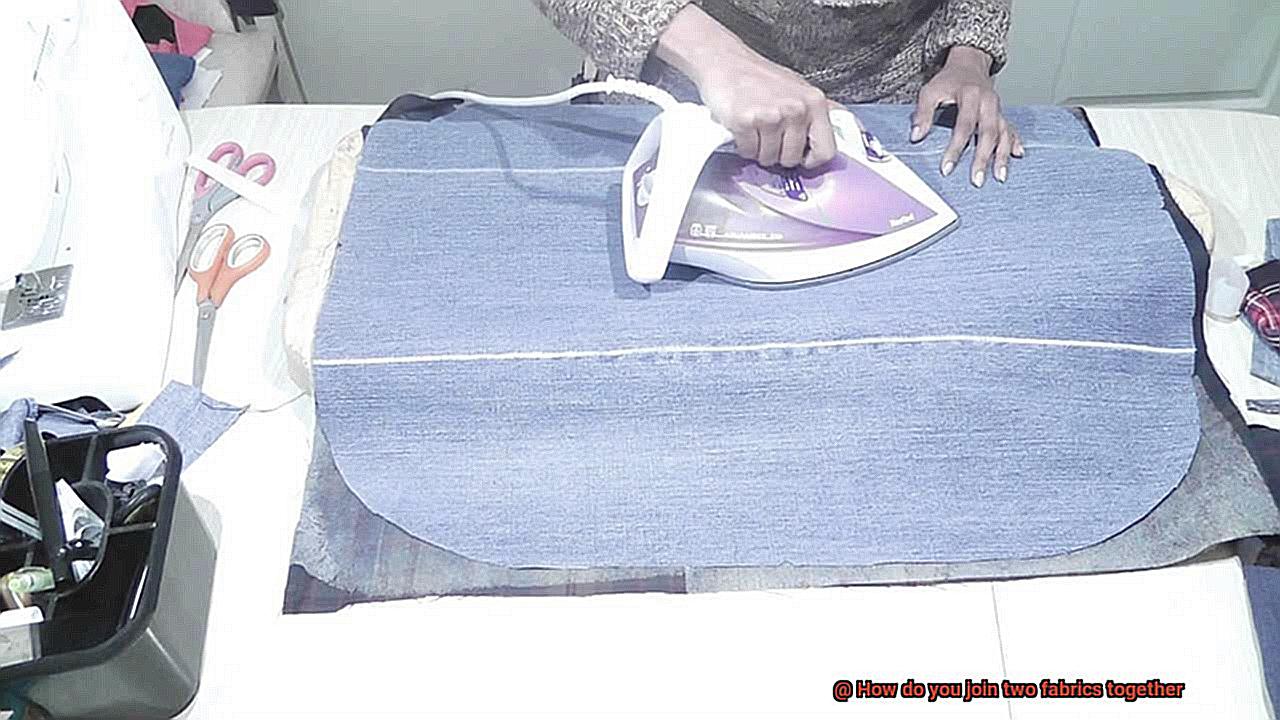
Sewing, the tried-and-true hero of fabric joining methods, has a range of advantages that make it a popular choice for many projects. Let’s explore the benefits of sewing in more detail:
- Durability: One of the key advantages of sewing is its durability. When fabrics are sewn together using high-quality thread and proper stitching techniques, the resulting seam is strong and long-lasting. This makes sewing ideal for creating garments, accessories, and home decor items that need to withstand regular use and washing.
- Versatility: Sewing allows for a wide range of techniques and stitches, offering endless possibilities for creativity. From basic straight stitches to intricate embroidery, sewing allows you to customize your projects and add unique details. Additionally, sewing can be done by hand or with the use of a sewing machine, giving you the flexibility to choose the method that suits your skills and preferences.
- Professional Finish: Sewn seams have a polished and professional appearance. The neatness of sewn seams adds a level of sophistication to garments and other sewn items, making them look well-crafted and refined.
- Customization: Sewing gives you the freedom to customize your projects according to your preferences. Whether it’s adjusting the fit of a garment, adding embellishments, or combining different fabric types, sewing allows you to create unique pieces that reflect your personal style.
While sewing has numerous advantages, it also has some limitations to consider:
- Time-consuming: Sewing can be time-consuming, especially when working on complex projects or intricate designs. Each stitch needs to be carefully executed, requiring patience and attention to detail. Additionally, certain sewing techniques may require multiple steps or additional equipment, further adding to the time investment.
- Skill and Learning Curve: Sewing is a skill that requires practice and learning. While basic stitches can be easily mastered, more advanced techniques may take time to develop. Beginners may find it challenging to achieve professional-looking results initially and might need guidance or instruction to improve their skills.
- Limited to fabric materials: Sewing is primarily used for joining fabrics together and may not be suitable for other materials such as plastics, leather, or metal. While some sewing machines have the capability to handle thicker or tougher fabrics, there are still limitations to the types of materials that can be sewn effectively.
- Not suitable for all projects: While sewing is versatile, there are instances where other methods of joining fabrics may be more appropriate. Gluing or taping might be preferred for temporary or quick fixes, or when dealing with delicate fabrics that could be damaged by stitching. It’s important to consider the specific requirements of each project and choose the most suitable method accordingly.
Using Fabric Glue: Advantages and Limitations
Fabric glue is like the trusty sidekick that swoops in to save the day when sewing is not an option. It offers a convenient alternative for those who lack sewing skills or access to a sewing machine. Let’s delve into the advantages and limitations of using fabric glue.
Advantages of Using Fabric Glue:
- Ease of use: Fabric glue doesn’t require any special skills or equipment. It’s a quick and easy process—simply apply the glue to the fabric, press the pieces together, and allow it to dry. This makes it suitable for beginners or those who need a fast solution.
- Quicker alternative: Sewing can be time-consuming, especially for intricate designs or delicate fabrics. Fabric glue provides a quicker bonding process, which is beneficial for quick repairs or last-minute alterations.
- Versatility: Fabric glue can be used on various types of fabrics, including cotton, polyester, silk, and even leather. This makes it suitable for a wide range of projects, from clothing repairs and alterations to crafting and upholstery.
- Strong bond: When used correctly, fabric glue provides a sturdy bond that can withstand regular wear and tear. It’s suitable for both temporary fixes and permanent fabric joining.
- Flexibility: Unlike traditional stitches that can limit the movement of fabrics, fabric glue allows for more flexibility and stretch. This is particularly useful when working with stretchy or elastic materials.
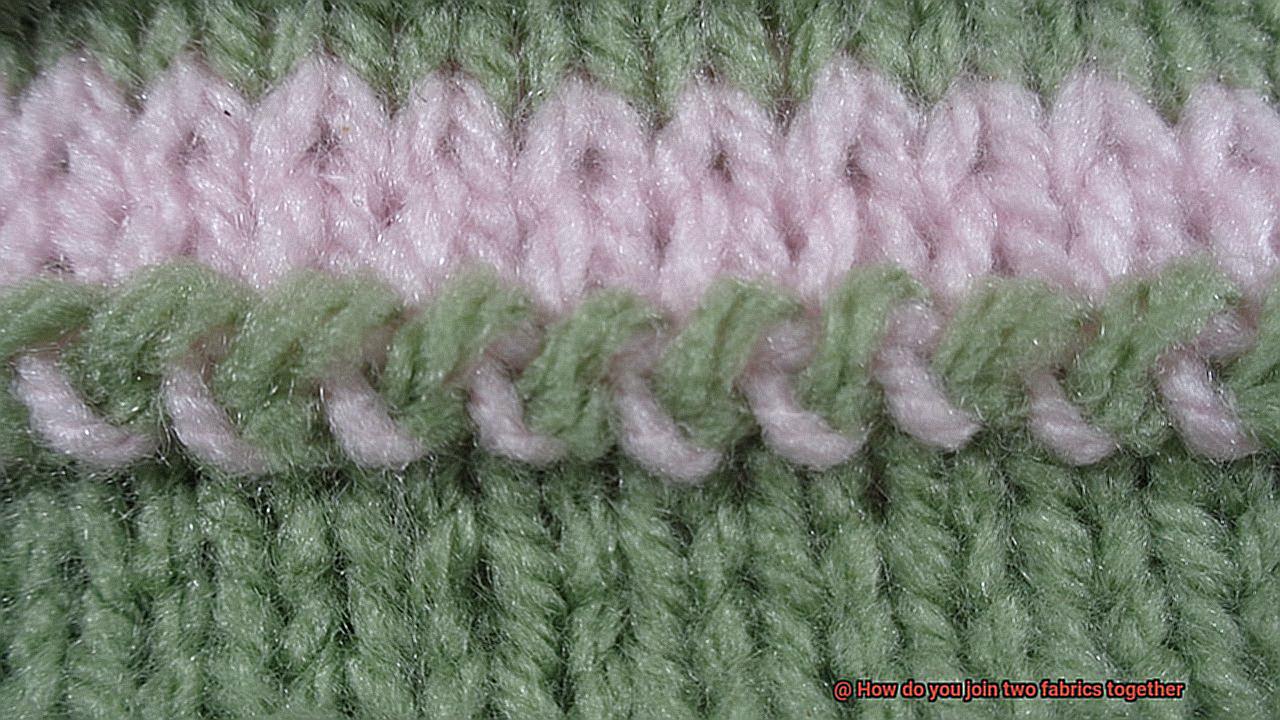
Limitations of Using Fabric Glue:
- Durability: While fabric glue can provide a strong bond, it may not be as durable as stitched seams, especially in high-stress areas such as clothing seams or heavy-duty items.
- Suitability for certain fabrics or projects: Delicate or sheer fabrics may be damaged by the chemicals in fabric glue. It’s important to test the glue on a small area before applying it to the entire fabric. Additionally, fabric glue may not be suitable for joining heavy fabrics or materials that require a strong and secure bond.
- Aesthetic appeal: While fabric glue can provide a strong bond, the appearance of the glued area may not be as seamless or polished as stitched seams. This is especially true for visible areas or garments where a neat finish is desired.
- Proper usage and storage: Fabric glue should be used with caution and in accordance with the manufacturer’s instructions. Ensure proper ventilation when working with fabric glue, as it can emit strong fumes. Additionally, store fabric glue properly to maintain its effectiveness and prevent drying out.
Fusible Web or Tape: Advantages and Limitations
Fusible web or tape is a game-changer when it comes to joining fabrics. Its advantages are numerous, but it’s important to be aware of its limitations as well.
Advantages:
- Easy to use: Simply cut the web or tape to size, position it between the fabrics, and apply heat using an iron or heat press. Voila. The adhesive melts and bonds the fabrics together, creating a strong connection. No advanced sewing skills required.
- Versatile: Fusible web or tape works with a wide range of fabrics, including cotton, polyester, silk, and denim. This makes it ideal for various projects like quilting, appliqué, garment construction, and home decor.
- Seamless finish: Unlike traditional sewing methods that leave visible stitches, fusible web or tape creates an invisible bond between fabrics. This is particularly useful when you want to avoid unsightly stitching lines, such as when attaching fabric patches or appliqués.
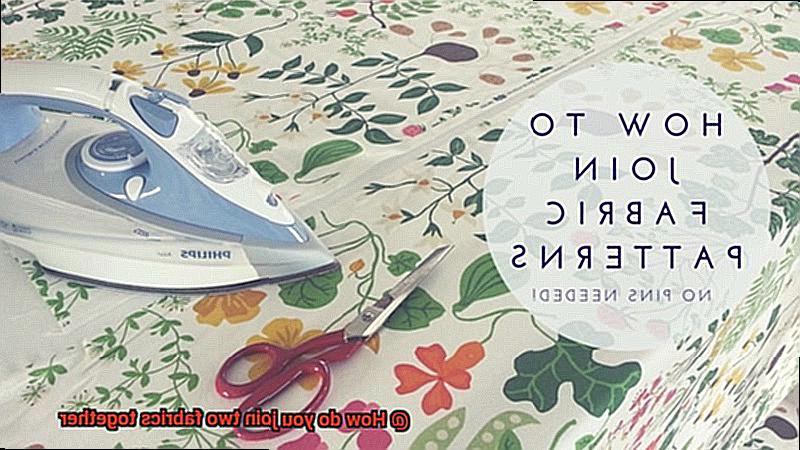
Limitations:
- Sensitivity to heat: Delicate fabrics like silk or rayon may not tolerate high temperatures and could be damaged during the fusing process. It’s always a good idea to test a small piece of fabric before committing to the entire project.
- Durability concerns: While fusible web or tape provides a secure connection for most projects, it may not hold up well under heavy wear or frequent washing. If durability is a priority, reinforcing the bond with additional stitching is recommended.
- Not suitable for all projects: If you need flexibility or stretch in your fabric, such as in garment seams or active wear, fusible web or tape may not be the best choice. Sewing methods offer more give and flexibility in these cases.
Iron-on Patches: Advantages and Limitations
Iron-on patches offer numerous advantages when it comes to joining two fabrics together. One of the main benefits is the ease of application. Unlike other methods like sewing or gluing, iron-on patches require minimal effort and skill. With a simple process of placing the patch on the desired area, covering it with a cloth, and applying heat using an iron, anyone can attach these patches to various fabrics without hassle.
Versatility is another advantage of iron-on patches. They can be used on a wide range of fabrics, including popular choices like cotton, denim, and polyester. This makes them suitable for different types of clothing or accessories, allowing individuals to personalize their items according to their preferences.
In terms of durability, iron-on patches excel. Once properly attached, they can withstand regular washing and wear without coming off easily. This makes them ideal for garments or items that are subject to frequent use or movement, ensuring that the decorative or functional elements added to fabrics last for a long time.
Iron-on patches also provide a multitude of design options. They come in various shapes, sizes, colors, and patterns, allowing individuals to express their unique style and creativity. Whether it’s adding a logo to a t-shirt or repairing a hole in jeans with a decorative patch, these patches offer endless possibilities for customization.
However, iron-on patches also have limitations that need to be considered. Delicate or heat-sensitive fabrics may not withstand the high temperatures required for attaching these patches. It is crucial to check the fabric’s care instructions and test a small area before applying the patch to avoid any damage.
While generally durable, iron-on patches may not be as secure as sewing or other adhesive methods. Excessive heat or friction can cause them to come off. To ensure their longevity, reinforcing them with additional stitching along the edges is recommended.
Moreover, intricate designs may lose some detail during the heat application process. Fine lines or small text may not appear as sharp as desired. If precise details are crucial, alternative methods like embroidery or screen printing may be more suitable.
Fabric Adhesive Tapes: Advantages and Limitations
Fabric adhesive tapes offer several advantages for joining two fabrics together.
Firstly, they provide convenience as they eliminate the need for sewing or stitching, making them a quick and efficient solution for fabric bonding. Secondly, these tapes are versatile and can be used on a wide range of fabrics, including cotton, polyester, nylon, and more.

This makes them suitable for various sewing and crafting projects. Additionally, fabric adhesive tapes offer flexibility, allowing for greater mobility and stretchability in fabric joints.
This is particularly beneficial for garments or accessories that require movement. Moreover, when applied correctly, fabric adhesive tapes provide a strong and durable bond that can withstand regular wear and tear, washing, and even dry cleaning.
This makes them suitable for long-lasting fabric repairs or bonding projects. However, fabric adhesive tapes also have limitations.
They are not suitable for heavy-duty fabrics or high-stress areas where the tape may peel or come loose over time. Additionally, some fabric adhesive tapes may not hold up well under frequent washing or exposure to water.
It is important to check the specifications and recommendations provided by the manufacturer to ensure the tape’s suitability for these conditions. Aesthetic considerations should also be taken into account as fabric adhesive tapes may not provide the same seamless finish as sewing.
The tape may be slightly visible or leave a residue on the fabric surface.
Choosing the Appropriate Method for Your Project
Choosing the appropriate method for joining two fabrics together is a critical step in ensuring that the bond is strong and durable. With a plethora of methods available, it can be overwhelming to determine which one is best suited for your project. However, fear not. By considering factors such as fabric type, intended use, and personal preference, you can confidently choose the perfect method.
One popular and versatile method is sewing. Armed with a needle and thread, you can stitch the fabrics together with ease. Sewing provides flexibility, allowing you to easily undo stitches if necessary. Reinforcing the seams with techniques like backstitching ensures a secure and long-lasting bond. This method is suitable for most fabric types and offers the freedom to create intricate designs.
If you’re looking for a quick and easy alternative to sewing, adhesive or glue may be your best bet. Glues specifically designed for fabric bonding are readily available and offer a strong bond that can withstand regular wear and washing. However, it’s crucial to choose the right glue for your fabric type as some may not adhere effectively.
Heat bonding is another option that provides a secure bond resistant to washing. This technique involves using heat to activate an adhesive film that bonds the fabrics together. Although commonly used in industrial settings, it can also be done at home using an iron or heat press. Heat bonding works well with a wide range of fabric types and ensures a strong bond that stands the test of time.
For those seeking a more decorative approach, embroidery or appliqué are excellent choices. Embroidery involves stitching designs onto the fabric surface while simultaneously joining two fabrics together. Appliqué, on the other hand, entails attaching cut-out fabric shapes onto a base fabric using stitching or adhesive. These methods allow for endless creativity and customization while still ensuring a secure bond between fabrics.
V-X1xJ_Z83M” >
Conclusion
In conclusion, the act of joining two fabrics together is an essential step in any sewing or crafting endeavor. Whether you’re fashioning a garment, mending an item, or adding decorative touches to your fabric, selecting the right method for fabric joining is paramount.
Sewing, a time-honored and versatile technique, offers durability, adaptability, and a polished final result. It permits customization and establishes a robust bond between fabrics. However, it demands patience and expertise to achieve impeccable stitches.
Fabric glue grants convenience and simplicity. Suitable for various fabric types, it facilitates a swift bonding process. Nevertheless, it may not possess the same longevity as sewing and might lack the refined appearance.
Fusible web or tape creates an imperceptible bond between fabrics with ease of use. It harmonizes well with different fabric types but may not be ideal for delicate materials or projects requiring flexibility.
Iron-on patches serve as excellent solutions for fast and effortless fabric joining. They provide versatility in design options but may not offer the same level of security as sewing or other adhesive methods.
Fabric adhesive tapes deliver convenience and flexibility but may falter under heavy-duty conditions.
When selecting the appropriate method for your project, take into account factors such as fabric type, intended use, durability requirements, and personal preference. Each approach boasts its own merits and drawbacks; therefore, choose wisely to ensure a sturdy and enduring union between your fabrics.

